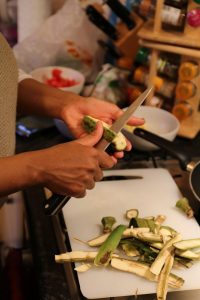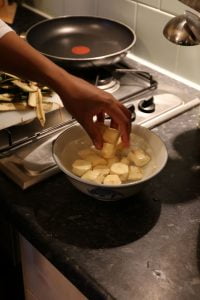One popular celebratory dish in Tanzania is matoke, a meal of cooked, unripe bananas, but not at all like the bananas we have here in North America. It’s very unlikely you’ll find matoke at your local supermarket, but if you do – we recommend you grab them and use the recipe below to make your own Tanzanian feast!
While the dish is popular throughout East Africa, the Tanzanians have their own style of preparation in that they add beans to the dish along with some cow meat which must contain a piece that is full of fat to flavor the food. Another much loved Tanzanian food is makande – a mixture of maize, beans and coconut milk cooked together. Learn how to make these dishes with these recipes from Albatros Travel.
Matoke
Matoke are shorter than ordinary bananas. They appear to be thick at the mid section due to their shorter than average length. The peel is green in color when they are unripe, which is the state in which they are most commonly used. The flesh is particularly hard due to the high starch content. It is necessary to cook the matoke very well prior to consumption. The most common methods of cooking the matoke are boiling, steaming or roasting. Once they are cooked, the flesh turns yellow, and if cooked well when boiled, should soften to about the same consistency as potatoes. They will however still hold their form.
If the green matoke, with its slight metallic luster is left for too long, they will ripen as ordinary bananas would. When ripe, they are very sweet and can be eaten as normal fruit. Due to the high price, this is considered a waste because matoke is most loved as a green cooking banana and is something of a luxury.
Matoke cannot be peeled in the same way as ordinary bananas
when they are unripe. In fact, matoke are sometimes referred to as plantains because they are cooking bananas. Plantains are relatively easy to peel. They need to be cut at each end and slit along the length of the skin before peeling back. Matoke are a little more complicated.
To peel matoke, cut off the tips at each end of the banana. The banana, including the skin, is very hard such that it is not easy to penetrate with the tip of a knife. Therefore it is necessary to peel the skin off by placing the knife at one end of the cut off tips, ensuring it is just under the peel, and pulling back towards your body. This would be similar to peeling a potato with a knife. Extra care needs to be taken to do this in order to avoid any accidental cuts.
Once the green peel is off, this will reveal the white flesh of the matoke. When the flesh is exposed to air, it will quickly begin to discolor. In order to prevent this, immediately place the peeled bananas into a bowl of salted water. Completely submerge them to ensure the air is kept away until you have peeled the entire batch. They are now ready to cook.
The simplest method is to boil them for up to 30 minutes. Check for doneness in two ways. First check that the color has changed to yellow. To ensure it has been cooked well, pass a fork or knife through a piece. If it goes through without much resistance, they are ready to eat.
Makande
Ingredients
225 g red kidney beans
1 onion
2 garlic cloves
75 g coconut milk
225 g sweet corn
300 ml vegetable stock or water
salt, to taste
Preparation
- Drain the kidney beans (which were soaked overnight) and place in a pan. Cover the beans with water and boil rapidly for 15 minutes. Reduce the heat and continue boiling for about one hour until the beans are tender, adding more water if necessary. Drain and discard the cooking liquid.
- Place the beans in a clean pan with the onion (chopped), garlic (crushed), coconut, sweetcorn and salt.
- Add the stock or water, bring to the boil and simmer for 20 minutes, stirring occasionally to dissolve the coconut.






Leave A Comment
You must be logged in to post a comment.